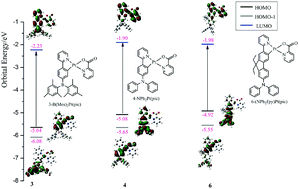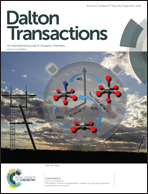A theoretical study on tuning the electronic structures and photophysical properties of newly designed platinum(ii) complexes by adding substituents on functionalized ligands as highly efficient OLED emitters†
Abstract
By imitating FIrpic, seven new platinum(II) complexes with pic (pic = picolinate) ligand have been designed to be guest materials by means of adding different substituents to functionalized ligands (ppy and fpy, ppy = phenylpyridyl-N,C and fpy = 2-(9′,9′-diethyl-9H-fluorenyl)pyridyl-N,C). In order to reveal their molecular structures, photophysical properties and structure–property relationships with typical host materials, an in-depth theoretical investigation was performed via quantum chemical calculations. The electronic structures and photophysical properties of these complexes were investigated by density functional theory (DFT) and time-dependent density functional theory (TDDFT) using the B3LYP functional with LANL2DZ and 6-31G* basis sets. It turns out that electronic structures and photophysical properties can be tuned by substituent modifications on functionalized ligands. This work highlights that the match between guest materials and host materials in typical OLED structures can be weighed by the energy levels of the HOMO and LUMO and the adiabatic triplet energy of each complex. Also, a combined analysis of electronic structures, host–guest match, reorganization energies (λ) and triplet exciton generation fraction (χT) is helpful in exploring triplet emitters with high phosphorescence efficiency in OLEDs, which is an interesting and creative aspect of this work. Thereinto, λ reveals the capability of carrier transport and the balance between holes and electrons, whilst structural parameters and d-orbital splittings show that those complexes that have strong electron-withdrawing and electron-donating groups are nonemissive. Consequently, complexes 3–7 can be better triplet emitters than FIrpic. Moreover, the emission colors could be predicted by the 0–0 transition energy (E0–0) instead of the triplet vertical transition energy (Evert). Accordingly, complexes 3, 4 and 6 would be efficient phosphorescent materials with different predicted emission colors.


 Please wait while we load your content...
Please wait while we load your content...